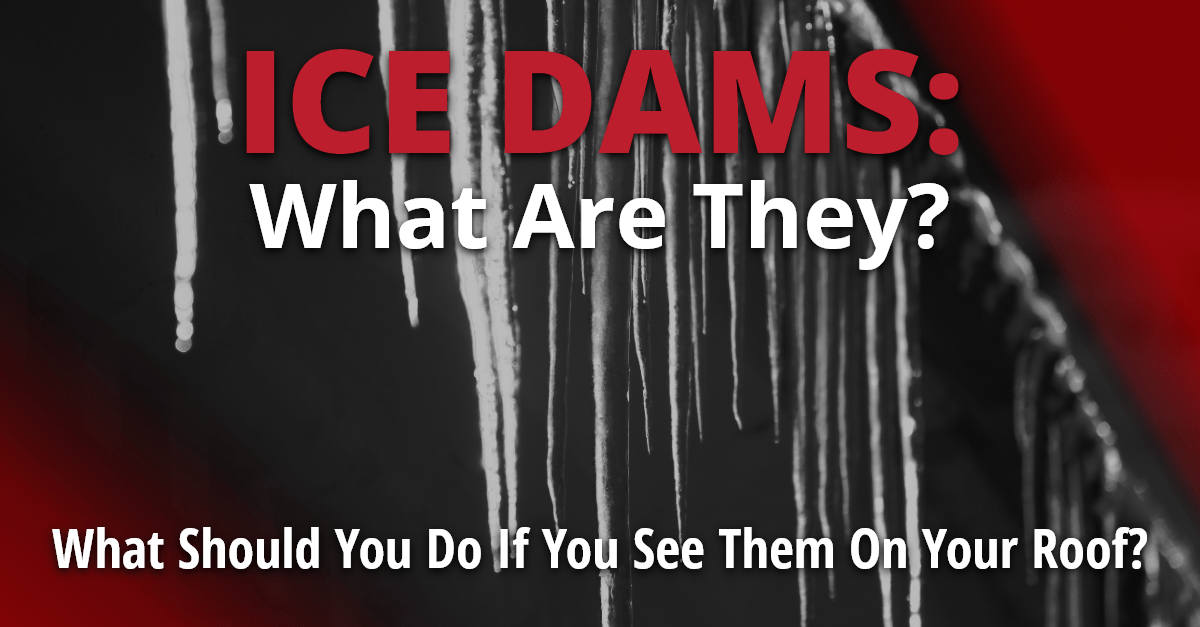What Are Ice Dams?
If you live in an area with heavy snowfall, you should be aware of the risks to your roof. Too much snow and ice accumulation could lead to roof damage, leaks, and in the worst cases, roof collapse. Snowfall presents a risk to homeowners primarily because of ice dams, which are big sheets of ice along the roof’s edge.
But, there is some good news: ice dams and the damage they cause are preventable. Keep reading to learn the basics about snow load, ice dams, and winter roof protection.
How Do Ice Dams Form?
You’ve probably seen ice dams on your own or at a neighbor’s home. They look like large icicles cascading over the roof’s edge. These ice dams form over days or weeks. While they may look beautiful, they pose a serious risk.
Roofs are the warmest near the peak. So, any snow that falls on the peak may melt and trickle down towards the roof’s edge. The roof’s edge is generally colder, so it re-freezes when water reaches this point. This warming and re-freezing happens repeatedly, causing the ice dam to keep growing. Eventually, the ice dam gets tall enough that new water can’t trickle over the roof’s edge into the gutters. It gets blocked by the ice dam and becomes part of the dam.
What Damage Do Ice Dams Cause?
Ice dams can cause several types of damage to your home and roof.
Peeling Shingles
When water first trickles toward the edge of your roof, some of it may get caught under the edges of your shingles. As this water freezes, it expands, prying the shingles off the roof’s surface. Large ice dams can cause extensive shingle damage. Once the ice dam thaws and you get a windy day, those shingles may blow off entirely.
Damaged Gutters
Ice dams often settle into gutters. As the water freezes and expands, it can blow out the seams of gutters or weigh them down. Damaged gutters put your siding, foundation, and landscaping at risk for water damage once spring comes.
Leaks and Mold Growth
Shingles that have been pried from the roof’s surface often cause leaks. Even if they only let in a small trickle of water, this is enough to cause mold growth in your attic. The water may trickle down the ceilings into the top floor of your home, leading to additional drywall damage and mold growth.
Sagging and Collapsing Roofs
Ice dams are heavy. Ice is much denser than snow; what looks like a bit of ice can weigh hundreds or even thousands of pounds. Over time, the weight of a large ice dam may cause your wooden roof deck to crack. This will cause your roof to start to sag. While it is rare for roofs to collapse due to snow loads and ice dams, it does happen.
If you have large ice dams on your roof, keep an eye on your interior doorways and window frames. If the tops of your doorways and window frames start to sag, this is a sign there’s too much weight on your roof, and it may be at risk for collapse. Contact your roofer ASAP.
How Do You Prevent Ice Dams?
In the short term, some people prevent ice dams by raking snow off their roofs before it has a chance to melt. But for long-term ice dam prevention, you must focus on the roof itself. A roof designed to stay cold, even near the peak, will not develop ice dams. Instead, the snow that falls on the roof will remain frozen. Much of it will tumble off — or you can push it off — reducing the weight on your roof.
There are two critical components to long-term ice dam prevention: insulation and ventilation.
If your attic is well insulated, less heat will travel up from your home through the roof. The insulation will trap the heat inside your home where it belongs. Many attics are under-insulated. Energy Star recommends 10 – 14 inches of insulation for most attics. If yours has less than this, have your roofer add more for ice dam prevention.
Ventilation allows warm air to escape from your attic, so it does not have to travel directly through your roof. If your attic is often humid and warm, it’s probably not vented properly. Talk to your roofer about adding a ridge vent or some soffit vents.
Properly insulating and ventilating your attic may not 100% prevent ice dams, but it will minimize them.
What Should You Do If You See Them?
It wouldn’t be fair to leave you hanging at this point. There are solutions to control ice damming and prevent roofing damage. There are a number of things that can help. We’ve already mentioned a couple of them. In the next post about ice and water shields, we’ll discuss your options and how they will give you peace of mind when Michigan winters dish out cold and snow. Then you can laugh like children sledding instead of worrying about your roof.
If you have concerns about ice dams or any other aspect of your roof, please do not hesitate to call Victors Home Solutions. We are located in Michigan and would love to help you with your roofing project!







